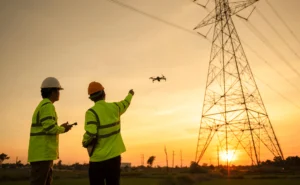In recent years, the integration of industrial drones into various sectors has brought about a transformative shift in the way we approach infrastructure inspection. The marriage of cutting-edge technology with traditional practices has resulted in more efficient, accurate, and safer methods for evaluating critical structures such as bridges, power lines, and pipelines. This paradigm shift from blueprint-based inspections to real-time aerial assessments is reshaping the landscape of infrastructure management. Traditionally, infrastructure inspection has been a time-consuming and resource-intensive task, often requiring manual labor and specialized equipment. The advent of industrial drones has revolutionized this process by enabling remote data collection and analysis. Equipped with advanced imaging systems, LiDAR sensors, and high-resolution cameras, drones can capture intricate details of structures from vantage points that were once inaccessible. This aerial perspective not only expedites the inspection process but also enhances the accuracy of defect detection.

One of the most significant advantages of using drones for infrastructure inspection is the safety aspect. Many critical structures are located in hazardous environments, making manual inspections risky for workers. Drones eliminate the need for personnel to physically access these sites, reducing the potential for accidents and injuries. This aspect is particularly crucial in industries such as energy and transportation, where workers often face perilous conditions. Moreover, the data acquired by industrial drones provide a comprehensive view of the condition of infrastructure elements. Advanced algorithms and machine learning techniques can process the collected data to identify signs of deterioration, corrosion, and other structural issues that might not be visible to the naked eye. By analyzing this data, engineers and maintenance teams can make informed decisions about necessary repairs and maintenance, ultimately extending the lifespan of these structures and preventing catastrophic failures. The transition from blueprint-based inspections to drone-enabled evaluations has not been without challenges.
The implementation of drone technology requires skilled operators who are proficient in both piloting and data analysis. Additionally, regulatory hurdles and privacy concerns have necessitated the establishment of guidelines and protocols for drone usage. As the technology matures and regulations become more refined, these challenges are gradually being addressed. Looking ahead, the integration of drones into infrastructure inspection holds immense ats promise. The data collected by drones can be incorporated into Building Information Modeling BIM systems, creating a digital twin of the structure that facilitates ongoing monitoring and predictive maintenance. This real-time feedback loop allows for a more proactive approach to infrastructure management, preventing potential issues before they escalate. In conclusion, the journey from blueprint to reality in the realm of industrial drones has redefined the way we inspect and manage critical infrastructure. These aerial vehicles have transcended conventional inspection methods by offering enhanced efficiency, accuracy, and safety. While challenges persist, the evolution of drone technology continues to reshape the landscape of infrastructure inspection, ensuring the longevity and resilience of our vital structures.
